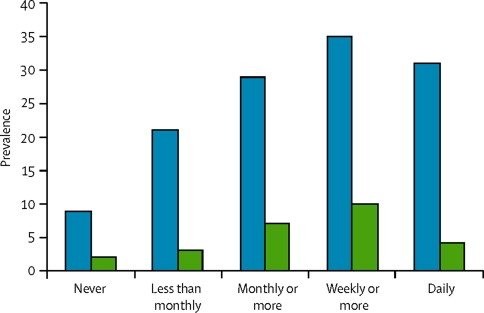Rethinking dose-response effects of cannabis use in adolescence
14 de novembro de 201414min0


Cannabis is increasingly a prescribed drug and is even legal in some countries. It is timely then that a recent study by Edmund Silins and colleagues1 in The Lancet Psychiatry reported associations between cannabis use in adolescence and a range of important life outcomes. Combining data at a participant level from three longitudinal cohort studies in Australia and New Zealand, and controlling for an impressive number of confounding variables, Silins and colleagues report that increased frequency of cannabis use before age 17 years predicted reduced likelihood of completing high school or gaining a university degree alongside increased risk of cannabis dependence, use of other illicit drugs, and attempted suicide.
Silins and colleagues conclude that the reported associations showed a dose-response relation with cannabis exposure. The models they tested assumed a linear effect of cannabis according to maximum reported frequency of use (never, less than monthly, monthly or more, weekly or more, or daily) before age 17 years. These proxies of use might not reflect actual dose (of delta-9-tetrahydrocannabinol) because of variation in cannabis potency and patterns of use.2 Nevertheless, it is reasonable to assume that dose increased progressively but in a non-linear manner from never to daily user groups. For example, the difference between never and less than monthly might reflect a tiny amount of cannabis (perhaps a few joints in one’s lifetime), whilst escalating from weekly or more to daily can reflect a large increase in cannabis consumption.
The authors report that categorical representations of cannabis use did not improve the model fit over and above a linear model. However, we believe that a categorical analysis could supplement their findings and aid interpretation of dose-response effects. Silins and colleagues assert that strongest effects were shown in daily users, which seems to be true for cannabis dependence, but not for the other outcomes that were robust to confounding. Daily users did not fare worse than weekly users for rates of school completion or degree attainment, whereas use of other illicit drugs was 4% lower, and suicide attempts were 6% lower in daily than weekly users (figure). It is possible that these trends in the raw data can be explained by confounding or sampling error or both in the daily use group because of low frequencies, especially in rare outcomes like suicide attempts. Alternatively, daily use might not carry greater risk for these outcomes than weekly use. If so, this absence of a clear dose-response profile might either suggest a non-linear relation or, more likely, question the argument of causality.
Cannabis comes in many forms with some types like skunk or sinsemilla containing very high levels of delta-9-tetrahydrocannabinol, but without cannabidiol, an ingredient that off-sets some harmful effects of delta-9-tetrahydrocannabinol on cognition and mental health.3 As legislative changes pave the way for the next generation of cannabis users, future prospective longitudinal cohort studies could benefit from biological quantification of concentrations of major cannabinoids ingested3 and biological indicators of degree of use4 to more clearly characterise dose-response effects.
We declare no competing interests.
References
1 . Young adult sequelae of adolescent cannabis use: an integrative analysis. Lancet Psychiatry 2014; 1: 286-293. PubMed
2 . The ‘grass ceiling’: limitations in the literature hinder our understanding of cannabis use and its consequences. Addiction 2011; 106: 238-244. CrossRef | PubMed
a Clinical Psychopharmacology Unit, University College London, London WC1E 6BT, UK


